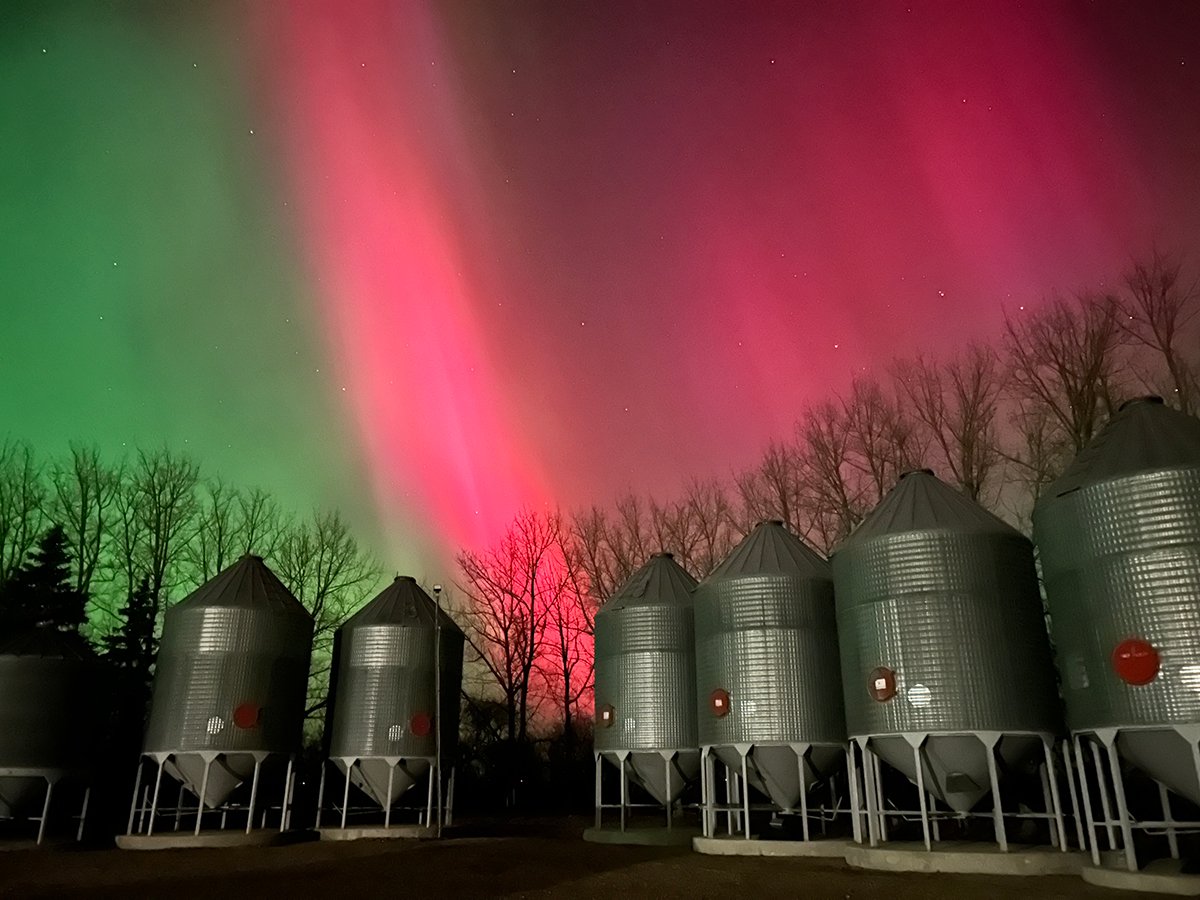BURGOYNE, Ont. – The Ball family decided to get off their work treadmill, so they moved to a larger farm last year.
Kevin and Elaine Ball had both worked off-farm jobs to support their 130 acres near Thamesford, Ont., but that size of farm “doesn’t cut it any more,” she said.
Tired of 16 hour days, they began looking around for a bigger chunk of land where they could just farm. They found 289 acres near Lake Huron where land was cheaper and the heat units enough to grow the corn and soybeans they were used to.
Read Also

Powerful solar storm lights up night time sky
Prairie skywatchers have been on high alert the last few nights as spectacular aurora displays have made the night time…
“We plowed two fields, but apparently that’s not done here,” said Elaine of the predominant cattle and pasture operations that surround them.
Spring 2000 meant a lot of work. They had bought the new farm in February and moved to it on April 8 in a snowstorm. After the snow they began seeding. And then there were three barns on the farm that were full of manure, which needed to be spread.
Last year their soybeans did well, but it was too cold and rainy for the corn. Elaine laughs at a memory of the neighbours blaming them for the bad weather because they left the former owners’ candy cane Christmas decorations up for view long past the season.
The Balls also uprooted their three sons and one daughter when they moved them three hours farther north and west. They expect that a couple of the boys, after university and some job experience, will return to farm with them. Part of the reason for the move was for the kids who wanted to farm, Elaine said.
With their new operation, the Balls inherited a flock of 130 laying hens. They have plenty of regular customers for the eggs, and demand rises in summer because they are on the resort route to cottages on Lake Huron 10 kilometres away.
They had sheep in Thamesford, and have re-established a commercial sheep meat flock on the new farm. They are also considering getting a few beef heifers. Their old farm had 400 hogs, but restrictive guidelines in their new township mean they can’t have more than 50 animal units per 100 acres.
“You can’t make a living off 200 hogs,” Elaine said.
They are close to Walkerton, Ont., where seven deaths were attributed to E. coli in the drinking water last year. Cattle were blamed for the contamination, but Elaine asks how many cottages have proper sewage disposal.
“We all have to do our part. We both do it responsibly and we’ll all come out right.”
While no longer working off the farm in a regular paid job, Elaine is active as a director of the Ontario Farm Women’s Network and works as a volunteer for the Ontario Rural Council umbrella group. Her main issues are the lack of rural child care and funding cuts expected next year to agricultural training in the province.
“When we lived in Thamesford we were labelled as part-timers by other farmers. We didn’t – we worked all day to pay off the debt and farmed until 11 or 12 at night …. Then we moved here where people accept off-farm jobs as a necessity.”
Kevin has casual work as a trucker, which he has time to do because it only took him three days to plant his corn this spring, and a day and half for the soybeans. One of his two tractors is a 1972 Case that he said he has had “longer than I’ve had my wife.”
Now in its 27th crop season, Kevin and his sons tinker to keep it going. He also has a 1977 John Deere with a new paint job. His wife teases him because he was supposed to be buying a smaller lawn type, but Kevin couldn’t resist the cheap price at the auction for the bigger machine.
Urban sprawl is common problem at both farms. In their new location, retired people move out of the cities to come to the lakeside area, and Hydro Ontario run its powerlines over the land. Near their old farm, an airport runway was 10 km away. Elaine joked that her husband said he’d hang on to the farm until the runway came out to it.
“Twenty-five years ago when I went to London, (Ont.,) the malls were out in the country. Now they are surrounded by houses,” she said.
Kevin and Elaine were raised on farms in southern Ontario, surrounded by other farmers. But today their neighbours are just as likely to be retired hydro employees or artists living in farmhouses or on hobby acreages. When they moved to the Burgoyne district last year, there were four dairy farms. This year there are two. One of the disappearing farms is becoming a golf course.
“I guess because our food is so plentiful, cheap and convenient, people don’t respect farming or agricultural land,” Elaine said.
“At some point I’m optimistic people will realize it has to come from Canada and people will start supporting us.
“I try educating people who come here to buy eggs. Most people are curious and want to know …. It’s important to take those opportunities to get people to know you.”
Elaine said her children will be farming differently than she and Kevin or their parents did. But “as long as they’re happy and can make a living, that’s good.”
Another issue dear to her is to support local stores and merchants, some of whom employ local teens, including their youngest son, Andrew. She shakes her head about people who complain about expensive prices in local grocery stores and then use up fuel to drive two hours to shop.
“If we all go to Kitchener or London to shop, then you may as well close up Port Elgin.”














